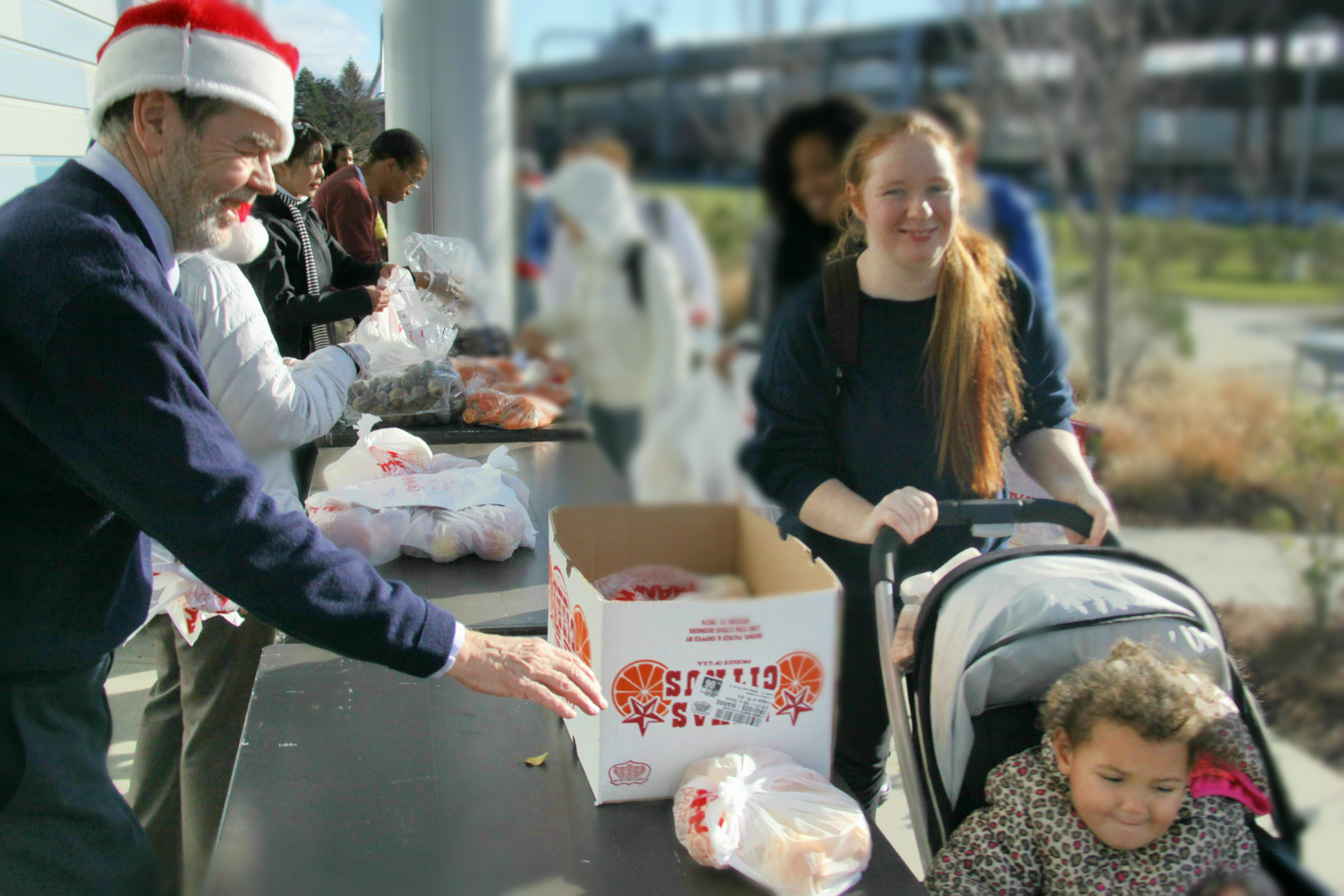
Bunker Hill Community College student Meaghan McGarrell, 23, picks up groceries at the school’s monthly food pantry. (Kirk Carapezza/WGBH)
There's a lot of focus in this country on making community college more affordable. But living expenses – including transportation, rent and food – are still the biggest barrier between students and graduation.
At Bunker Hill Community College in Boston, the line snakes around the gym and spills out onto the sidewalk. Nearly 200 students carry backpacks and roll baskets, hoping to fill them not with books, but with food.
This is one of hundreds of volunteer-run food pantries that have cropped up on college campuses across the country. The goal is to assist students in need this holiday season.
In the back of the line, 23-year-old Meaghan McGarrell of Hyde Park pushes her two-year old daughter in a stroller, picking up oranges, onions, potatoes, and other foods.
McGarrell is a single mom. On top of tuition, fees and other expenses like health care and clothing, she struggles to pay her $1,400 rent each month. Occasionally, she and her daughter have to scrounge for food.
"Last week they had a free frozen yogurt and I actually took her to get some frozen yogurt because frozen yogurt can be expensive and why not jump on that?" said McGarrell.
For students like McGarrell, this food bank has been essential, especially around the holidays.
"This is actually my second time doing it this semester and it’s helped so much. It will carry me through until next month, maybe even February. Especially the onions with her,” said McGarrell, pointing to her daughter. “She loves onions."
A new study by researchers at the University of Wisconsin's HOPE Lab finds McGarrell is not alone. One in five community college students are so poor that they can't afford to eat, and 80 percent of the total cost of a year in community college is books, transportation, health care and food.
In Massachusetts, 25 of the state's 28 public campuses are now assisting students in need of food assistance – up from 19 last year.
“The campuses wouldn’t open these food pantries if there wasn’t a need,” said Massachusetts Higher Education Commissioner Carlos Santiago.
The state doesn’t have accurate numbers on exactly how many students need assistance, partly because many students are too ashamed to ask for help. But Santiago is convinced it's a growing problem.
“There’s a degree of stigma attached to it, but if you’ve got a family to feed you do it,” Santiago said.
This much Santiago does know: hunger is not limited to community colleges.
"It's a system-wide issue. It impacts campuses across the three segments: community colleges, state universities and the UMass campuses are seeing it as well," he said.
Santiago speaks from experience. He knows firsthand what it's like to be a hungry student; while studying for his PhD at Cornell, he spent a lot of time thinking about where to get his next meal.

Massachusetts Higher Education Commissioner Carlos Santiago and his wife and oldest daughter, Azara and Lourdes. In 1976, while attending Cornell University, Santiago and his family were eligible for food stamps. (Courtesy of Carlos Santiago)
"I had a family and a one-year-old. I got a grant to go to the program. We were new to the area in Ithaca, New York, and we were eligible for food stamps," he said. "It got us through that first semester, and I recall of all the semesters I studied as a doctoral student that was the one time where I turned to my wife and I said, 'Let's go home, because we can't make this work. And yet, the food stamp program was very helpful."
Since then, federal and state governments have reduced financial aid, and the cost of college has shifted to students and families.

Bunker Hill Community College student Diane McManus collects food ahead of the Christmas holiday (Kirk Carapezza/WGBH)
Back at Bunker Hill Community College, student Diane McManus is collecting food ahead of Christmas. The 57-year-old mother of seven is studying culinary arts and she’s so hungry that sometimes she can’t focus on her studies.
"It’s heartbreaking, sometimes devastating, especially when you’re not just thinking of you but when you’re gonna provide for the ones that you have. Sometimes you beat yourself up because you try to think back as to what did you do?" said McManus.
Related: Working Stiff: Community College Students Struggle to Balance Jobs and School
Between classes and work, Diane doesn't have the time or resources to go to the regular food bank, so she appreciates the extra assistance on campus.
"It’s very difficult - the finances. Even though the kids are grown up and gone, I have a mortgage, condo fee, light bill gas bill," said McManus.
All financial barriers that stand between these low-income students and graduation day. Researchers say allowing low-income students to use both financial aid and food stamps will help them complete their degrees.
This is part of our ongoing series on community colleges, "College Material." To see the rest of our stories, visit College Material: Community Colleges Come of Age.










